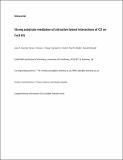Strong substrate mediation of attractive lateral interactions of CO on Cu(110)
Abstract
The mechanism of chemical reactions between adsorbed species is defined by the combined effects of the adsorbate–substrate potential landscape and lateral interactions. Such lateral interactions are therefore integral to catalytic processes, but their study is often complicated by “substrate mediation”, the regulation of a two-body potential between adsorbed particles by the surface itself. Substrate mediation can influence the sign and magnitude of lateral interactions. There are notable exceptions of ordered structures forming at low coverage, indicative of short-range attractive forces where repulsive forces are expected to dominate, suggesting a strong substrate-mediated contribution. To explore further the origins of such interactions, we have investigated the adsorption of CO on Cu(110) using a combination of low-temperature microscopy and first-principles calculations. Our studies reveal that lateral adsorbate interactions, which are constrained by the metal surface, regulate the bonding between the adsorbate and substrate. Anisotropic CO–CO coupling is seen to arise from a perfect balance between the intermolecular accumulation of charge that acts as a glue (chemical coupling) at sufficiently large distances to avoid repulsive effects (dipole–dipole coupling and Pauli’s repulsion between electron clouds).
Citation
Garrido Torres , J A , Finley , K L , Früchtl , H A , Webb , P B & Schaub , R 2019 , ' Strong substrate mediation of attractive lateral interactions of CO on Cu(110) ' , Langmuir , vol. 35 , no. 3 , pp. 608–614 . https://doi.org/10.1021/acs.langmuir.8b02808
Publication
Langmuir
Status
Peer reviewed
ISSN
0743-7463Type
Journal article
Description
Funding: Scottish Funding Council (through EaStCHEM and SRD-Grant HR07003), EPSRC (PhD studentship for JAGT, EP/M506631/1), Royal Society Industry Fellowship (PBW).Collections
Items in the St Andrews Research Repository are protected by copyright, with all rights reserved, unless otherwise indicated.

